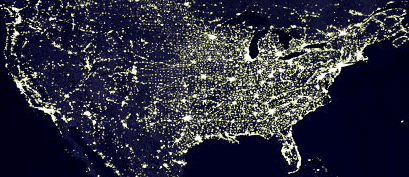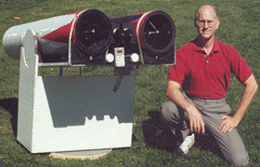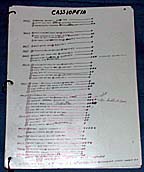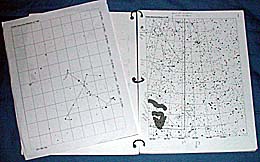

OBSERVATIONAL ASTRONOMY A survey of the best objects to look at in 15 constellations
(Click on main site to browse 70 other topics ranging from exotic kaleidoscope designs to the strange world of lucid dreaming.)
Here's a recent picture from the ISS of America at night... and you wonder why the sky doesn't seem as dark as it used to be.

Try this site: http://antwrp.gsfc.nasa.gov/apod/image/0011/earthlights_dmsp_big.jpg to see how bad light pollution is across the world.
The following list of what I think are the best astronomical objects for visual astronomy will unfortunately offend many people. I enjoy astronomy because I like to look at some of the beautiful things there are to see in the heavens. I would argue that for something to be beautiful it has to have enough detail for the beauty to be discerned. Small, soft, fussy objects may be interesting or provide satisfaction from the challenge of finding them but in my humble opinion aren't interesting. I want to see shapes and, if possible, colors. This limits my list to the largest, brightest, and most interestingly shaped objects in the sky. These are mostly asteristic open clusters (star clusters that have a shape that reminds the observer of some familiar object) and pairs of stars (not necessarily double stars) that exhibit contrasting colors. Most galaxies, nebulas and planetary nebulas do not have interesting-enough shapes to be on such a list.
Another requirement is that the objects be visible at low (30-100) power. I've spent too many nights listening to astronomers complaining that the atmosphere was too turbulent to use the high powers they needed for some small, dim object. They wait for hours, drinking coffee and ignoring their telescopes, hoping things will get better. At magnifications less than 100x conditions are seldom bad enough to prevent astronomy. Since I want to spend my time viewing and not waiting, I usually limit myself to these lower powers.
Now, having offended almost every astronomer who reads this, let me get onto the list. One final note, the shapes I assign to some open clusters are dependent on the cluster's orientation in the eyepiece. My instrument is a binocular that uses eight-inch, f8 mirrors for the primary objectives. The resulting image is inverted but correct left-to-right. Someone using a telescope with a different orientation may view these objects in such a way that the shapes are unrecognizable. Also, binoculars greatly enhance color perception so some of the colored pairs of stars I name may not show significant color in a monocular telescope.
Each object is followed by a rating in stars of how good I think it is. Two stars is interesting, four is excellent. Five stars is the highest I go and is only awarded to a truly outstanding sights like the Double Cluster.
I usually observe from Rock Rock Canyon State Park on California's high desert area - about 120 miles north of Los Angeles. It's reasonably dark with the conveniences of a ranger station and restrooms. It's only one hour from where I live.
I observe with an 8-inch, F8 binocular telescope.

I use a set of custom star charts made using The Sky, Level IV. The charts have the stars in the orientation as seen through my binocular telescope and scaled so that what I see through the 50 mm Plossel eyepieces looks the same size as what's on the charts. This required 1400 pages to cover the constellations visible from my area. Each constellation is bound separately with posterboard covers front and back.
 ........
........ 
The charts are printed on plain paper and as I observe I write notes directly on the charts. After finishing a constellation, I review all my observations and copy the important notes to the cover so I can quickly scan the best objects to revisit next time I look at that particular area of the sky.
Prior to an observing session, I review the charts, read through Burnham's on the constellation for the night, and review several lists of interesting objects and colored double stars to see what might be of interest. From these studies I make a list of primary targets. Going through the charts, I circle them and any additional interesting start formations that catch my eye. I then program my Orion Sky Wizard with enough additional reference objects so that I have at least two on every page in the chart.
Out in the field, I use a Telrad and the Sky Wizard to find and view all the circled objects and/or the programmed reference objects on one page. Once that's done, I locate one corner of the page in the eyepiece and star hop through the entire page, stopping at each new full view in the eyepiece to look for interesting asterisms. I repeat this process for each page for that particular constellation.

My admittedly
modest equipment case. One of the downsides
of using a
binocular telescope is that you have to have two
of everything.
I have two 50 mm Parks Plossels, two 2X
custom barlows
and two 3X custom barlows. I do
most of my
observing at 32X, only occasionally
resorting to
64X and 96X. It's difficult to
maintain good
image fusion above
64X because
frame flexure is
enough to
throw it off.
Right before I start to work on a constellation, I preform a quick exercise that greatly increases my sense of orientation. I figure out the position of the constellation relative to an imaginary line drawn from the center of our galaxy, through our position, and out toward intergalactic space. This gives me a feel for where I'm looking. When combined with estimated distances to the objects in that constellation it gives me a much greater sense of where I'm looking.
The
coordinates in the following constellations are given first in hours
and minutes
(1956 = 19
hours and 56 minutes), followed by decimal degrees (+14.6 = north
14.6 degrees or north 14 degrees 36 minutes.)
Aquila
1. Yellow and green stars at 1856+18.0 (3 stars)
2. White and blue stars at 1900+12.9 (3 stars)
3. Yellow and blue stars at 1915+15.1, outstanding! (4 stars)
4. Very attractive group of stars at 1926+2000, near NGC 6802 (3 stars)
5. M71 and NGC 6838 in same field at 1952+18.8 (3 stars)
6. Open cluster NGC 6709 at 1851+10.3 (3 stars)
7. Orange and white stars at 1916+09.2 (2 stars)
8. Intense red carbon star at 1904-05.7 (3 stars)
9. Yellow and white stars at 1905-04.0 (3 stars)
Auriga
1. Blue and orange stars at 0506+59.0 (2 stars)
2. Red and blue stars at 0517+53.6 (2 stars)
3. Green and orange stars at 0556+53.4 (2 stars)
4. NGC 1664 at 0451+43.7, looks like a royal scepter to me (2 stars)
5. Interesting group of stars shaped like a blackjack at 0456+44.3 (2 stars)
6. Bright solid orange star at 0637+38.4 (2 stars)
7. Open cluster NGC 2281 at 0650+41.1, reminds me of a pair of lips (3 stars)
8. "Pony" asterism at 0522+33.4, near open cluster NGC 1893 (2 stars)
9. Open cluster M36 at 0536+34.1, looks like a clown falling backward to me (3 stars)
10. Open cluster M37 at 0552+32.5 (2 stars)
Cassiopeia
1. Colored stars at 0001+67.3, green/yellow/white/red (2 stars)
2. Small condensation of stars at 0047+70.5 (2 stars)
3. Open
cluster (M52) at 2324+61.5 There is a loose condensation of stars
close to M52 that gives the combined pair the appearance of a duck
with the condensation being the duck's head. Best at 90x. M52 by
itself sometimes reminds me of a crab or turtle.
(3
stars)
4. Open cluster (NGC 7510) at 2304+60.6. A small, bright elongated cluster best at 100x. It reminds me of an cone with a flat base mounted on its point, like a cone-shaped chemistry flask. (2 stars)
5. Colored pair at 0001+60.4, bright dark orange/dim pale blue. (3 stars)
6. Open cluster (NGC457) 0119+58.3. A great cluster suggesting a bird or spaceship. Sometimes it even reminds me of the robot in the movie Short Circuit. Best at 65x. There is a good blue/yellow colored pair of stars at its feet. (4 stars)
7. Open cluster (NGC 225) 0044+61.8. About eighteen stars forming a caldron with two legs. Sometimes it looks more like the letter "W". Best at 50X (2 stars)
8. Open
cluster (M103) at 0134+60.6. A nice triangle of 5 bright and 13 dim stars.
(2
stars)
9. Colored pair at 0040+56.3, yellow/blue-white (2 stars)
10. Colored pair at 0049+57.8, bright white/intense red, needs 90x. (2 stars)
11. Colored pair at 0152+64.8, yellow/blue-green. (2 stars)
12. Open
cluster (NGC 654) at 0144+61.8, fan-shaped cluster, cute. Best at 90x.
(2
stars)
13. Open
cluster (NGC 663) at 0146+61.3. Reminds me of a winged horse. Best at 90x
(2
stars)
14. Open cluster (NGC 869 & 884) at 0221+57.1. The double cluster. (These are not really in Cassiopeia but it would be a shame to ignore them since they are so close and one of the greatest views in the sky.) Best at 30x and a wide-angle eyepiece. 884 is the more scattered cluster with the red star in its heart and at 8000 light years away is 1000 light years further away than 869. These clusters reside in the next spiral arm out, towards intergalactic space. (5 stars!)
15. Condensation of stars at 2321+48.0. Looks like a keyhole or a shoe. (2 stars)
16. Open cluster (NGC 7789) at 2357+56.6. This cluster has many dark rifts. Great at 90x (4 stars)
17. Asterism at 0027+54.2. Looks like Mr. Magoo's eyes when they are open. (2 stars)
18. Planetary nebula (M 76) at 0142+51.5. Its noticeable dumbbell shape makes this one of the few planetaries on my list. Best at 90x or more. (2 stars)
19. Asterism at 0008+67.3. Looks like the letter "J". (2 stars)
Delphinus
1. Colored pair of stars at 2042+20.5, red and blue, (1 star)
2. Skull-shaped asterism at 2104+12.4 (2 stars)
3. Colored pair of stars, white and yellow (3 stars)
4. Dolphin's Diamonds asterism at 2108+16.2 (2 stars)
5. NGC 6934, small globular cluster, good at 90X (2 stars)
Equelus
1. Colored pair of stars at 2122+04.2, pink and gray, (3 stars)
Lyra
1. White, yellow and blue stars at 1843+37.6, very pretty (3 stars)
2. Bright yellow and dimmer blue stars at 1850+33.3, striking (4 stars)
3. Yellow and blue stars at 1855+34.0 (3 stars)
4. Pipe clamp-shaped asterism at 1842+36.5, 35 minutes in diameter (3 stars)
Orion
1. Large bright open cluster at 0446+19.0, perfect at 32X (3 stars)
2. Large asterism at 0448+18.3, looks like a radar dish and tower (3 stars)
3. Open cluster M35 at 0609+24.3, perfect at 32X, no shape but bright (3 stars)
4. Small bright open cluster NGC 2169 at 0608+14.0, interesting shape (3 stars)
5. Beautiful brilliant orange-yellow star at 0555+07.4 (3 stars)
6. Nebula M42 at 0534-06.6, perfect at 32X, looks like an upside down vulture 5 stars
7. NGC 1977, nebula near M42 (2 stars)
8. White and blue star pair at 0533-00.5 (2 stars)
9. "Bow tie" asterism at 0549+19.0 (2 stars)
Pegasus
1. Galaxy (NGC 7331) at 2238+34.4. Bright and oval even at 32X. (2 stars)
2. Nice condensation of stars at 2240+38.5. (1 star)
3. Blue and white pair of stars at 2239+39.0. (3 stars)
4. Foot-print asterism at 2237+31.5. (1 star)
5. Very blue star at 2322+31.5. (1 star)
6. Yellow and orange pair of stars at 2334+31.2. (2 stars)
7. Curving-line (like a snake) asterism at 2147+29.5. (1 star)
8. Beautiful orange star at 2304+28.1. (1 star)
9. "Star" asterism at 2321+29.3. (1 star)
10. Nice, dark yellow star at 2122+19.5. (1 star)
11. Skull asterism at 2103+12.4. (1 star)
12. Globular cluster (M 15) at 2130+12.2. Small but outstanding even at 32X (4 stars)
13. "Y" asterism at 2132+11.3. Near M 15. (1 star)
Puppis
1. Open cluster (M46) looks like a diffuse globular 0741-14.8 (3 stars)
2. Open cluster (M47) bright 0736-14.5 (3 stars)
3. NGC 2506 at 0800-10.8 looks like a bright ladle filled with stardust (3 stars)
4. NGC 2539 at 0810-12.8 open cluster looks like a mushroom cap (2 stars)
5. NGC 2479 at 0856-17.8 open cluster looks like Bob Hope (3 stars)
6. Open cluster at 0718-24.0 just outside of Puppis, looks like a Xmas tree (4 stars)
7. M93 at 0744-23.8 looks like two nested "V"s at 90x (2 stars)
8. Galaxy (M33) at 0134+30.5. A large, oval fuzzy. (3 stars)
Sagitta
1. Colored pair of stars at 1939+16.5, yellow and blue, (3 stars)
2. Colored pair of stars at 2042+20.5, yellow and gray, same field as #1 (2 stars)
3. Dumbbell nebula, M27 at 1958+22.7, excellent! (4 stars)
4. Collinder 399, open cluster at 1926+20.0, near NGC 6802 (3 stars)
5. Walking stick asterism at 1945+24.4 (2 stars)
6. Open Cluster M71 at 1953+18.8, looks like a globular cluster (3 stars)
Scutum
1. Open cluster (NGC 6664) at 1837-08.2. 14 faint stars suggesting a "W". (2 stars)
2. Open cluster (NGC 6705) (M11) at 1853-06.3. Looks like a globular. (3 stars)
3. Colored pair at 1850-05.9. This greenish-yellow/white pair is just outside Scutum's border but it's too close to miss if you're in the area. (1 star)
4. Open cluster (M16) AT 1819-13.8. The Eagle nebula. Just a so-so cluster with a little nebulosity. (2 stars)
5. Nebula (M17) at 1821-16.2. The Swan or Omega nebula. A great sight. (This one's ....really in Sagittarius.) (4 stars)
6. Open cluster (NGC 6649) at 1834-10.4. A faint knot of 12 stars. (1 star)
Sextans
1. Mushroom-shaped asterism at 1011+06.5 (1 star)
2. Nice condensation of stars at 0951+06.4 (1 star)
3. Color star pair at 0952+05.1, white and pale blue (1 star)
4. Heart asterism at 1014+5.5 (1 star)
5. Umbrella asterism at 1003+04.7 (1 star)
6. Good star condensation at 1015+1.5 (1 star)
7. Color star pair at 1025+08.8 (Yellow and dim pale blue) (1 star)
8. Small, dim cluster-like condensation of stars at 1033+8.2. Like a sharp triangle with two bright stars at the base. Actually, this is just outside Sextans border. (2 stars)
9. Mountain or Pyramid asterism at 1050+2.5 (2 stars)
10. Color star pair at 1053+02.1 (White and dim blue or gray) (1 star)
11. Nice line of stars at 1048+02.8 degrees (1 star)
Triangulum
1. Galaxy (M33) at 0134+30.5. A large, oval fuzzy. (2 stars)
2. Cluster-like condensation of nine stars at 0150+27.1. (2 stars)
3. Open cluster (NGC 0752) at 0157+37.6. Large, loose and attractive. (2 stars)
4. Colored pair at 0213+30.2. Yellow and Blue. (1 star)
5. Colored pair at 0235+34.4. Yellow blue. (3 stars)
Ursa Major
It's hard to believe that a constellation with so much acreage has so little to offer.
1. Galaxies M81 and M82 (M33) at 0954+69.5. (1 star)
2. Dipper asterism at 0848+64.5 (1 star)
3. Little knot of stars at 0846+65.8 (1 star)
Vulpecula
1. Gold and green stars at 1931+28.0. Outstanding! One of the best! (5 stars)
2. NGC 6834, open cluster, long and interesting at 1950+29.4 (2 stars)
Yes, there are many more objects in these constellations than these few but in my opinion these are the best and worth the most attention. I apologize if I offended anyone by leaving out their favorites.